| Rye %: | 84% |
| Stages: | Stage 1 sponge, Stage 2 sponge, Final dough |
| Leaven: | Rye sour culture |
| Start to Finish: | 26-30 hours |
| Hands-on Time: | 35-45 minutes |
| Yield: | Two 2¾ lb./1.25 kg loaves |
The Danes are known for their rye breads, of which there are dozens of variations, all of which are called “Rugbrød.” Most are sweet and dense, loaded with seeds and coarse rye meal to provide both richness and a satisfyingly rustic coarse mouth feel.
This one is a different. Instead of the sweetness I’ve come to expect in Danish ryes, this one surprises with the intensity of its sour. Which isn’t surprising, considering that it’s built on a two-stage sour sponge that preferments over half of the total flour and ripens for a full 24 hours. Add to that the mild bitterness of a lager or Kolsch-style beer, and you get a bright sour-forward chew that slowly unfolds to reveal the spicy sweetness of the rye and rich nuttiness of a generous addition of pumpkin, sunflower, flax and sesame seeds. I like it spread lightly with cream cheese and topped with a slice of cured meat or fish, or with cold chicken breast, freshly ground black pepper and a mustard-mayonnaise dressing.
Stage 1 sponge (Day 1, Morning):
| Ingredient | Grams | Ounces | Baker’s Percentage |
| Wholegrain rye flour | 100 | 3.55 | 100% |
| Warm (105°F/41°C) water | 100 | 3.55 | 100% |
| Rye sour culture | 10 | 0.35 | 10% |
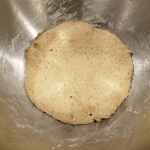 In the mixer bowl, combine the stage 1 sponge ingredients, cover and ferment at room temperature (70°F/21°C) 10-12 hours. The sponge will have doubled in volume and will have a strong acidic smell.
In the mixer bowl, combine the stage 1 sponge ingredients, cover and ferment at room temperature (70°F/21°C) 10-12 hours. The sponge will have doubled in volume and will have a strong acidic smell.
Stage 2 sponge (Day 1, Evening):
| Ingredient | Grams | Ounces | Baker’s Percentage |
| Stage 1 sponge | 210 | 7.45 | 31% |
| Wholegrain rye flour | 670 | 23.65 | 100% |
| Warm (105°F/41°C) water | 670 | 23.65 | 100% |
| Salt | 40 | 1.40 | 6% |
| Dark corn syrup or light molasses | 50 | 1.75 | 7% |
| Raw pumpkin seeds | 100 | 3.55 | 15% |
| Raw sunflower seeds | 100 | 3.55 | 15% |
| Brown flaxseed | 70 | 2.45 | 10% |
| Sesame seed | 35 | 1.25 | 5% |
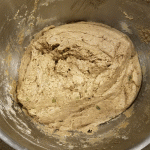 Add the stage 2 sponge ingredients to the Stage 1 sponge, mix by hand or machine to combine into a fairly stiff dough. Cover and let stand overnight, 10-12 hours, at room temperature. The sponge will have doubled in volume and show numerous broken bubbles on the surface.
Add the stage 2 sponge ingredients to the Stage 1 sponge, mix by hand or machine to combine into a fairly stiff dough. Cover and let stand overnight, 10-12 hours, at room temperature. The sponge will have doubled in volume and show numerous broken bubbles on the surface.
Final Dough (Day 2, Morning):
| Ingredient | Grams | Ounces |
| Stage 2 sponge | 1,945 | 69.00 |
| Coarse rye meal | 500 | 17.65 |
| Whole wheat flour | 235 | 8.30 |
| Beer | 320 | 11.30 |
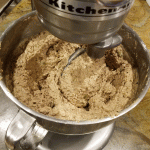 Add the final dough ingredients and use the dough hook to mix at low (KA 2) until evenly blended into a soft, sticky dough, 4-5 minutes.
Add the final dough ingredients and use the dough hook to mix at low (KA 2) until evenly blended into a soft, sticky dough, 4-5 minutes.
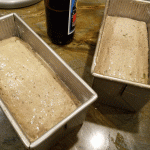 Put about 2¼ lb/1.5 kg into each of two well-greased 9 x 4 x 4-inch/23 x 10 x 10 cm. Pullman loaf pans, filling them about ² ⁄₃ full. Use wet hands and a plastic scraper to smooth the dough.
Put about 2¼ lb/1.5 kg into each of two well-greased 9 x 4 x 4-inch/23 x 10 x 10 cm. Pullman loaf pans, filling them about ² ⁄₃ full. Use wet hands and a plastic scraper to smooth the dough.
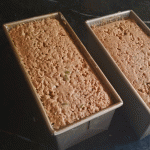 Cover and proof at room temperature until the dough has reached the rim of the pans and the top shows numerous broken bubbles, 3-5 hours.
Cover and proof at room temperature until the dough has reached the rim of the pans and the top shows numerous broken bubbles, 3-5 hours.
Preheat the oven to 435°F/225°C with the baking surface in the middle. Brush the tops of the loaves with water and bake without steam until the loaves thump when tapped with a finger and the internal temperature is at least 198°F/92°C, 75-90 minutes. Unpan the loaves, transfer to a rack and cool thoroughly before slicing.
| Ingredient |
g |
% |
| TOTAL FLOUR |
1,505 |
100.00% |
| Whole rye flour |
770 |
51.16% |
| Coarse rye meal |
500 |
33.22% |
| Whole wheat flour |
235 |
15.61% |
| Water |
770 |
51.16% |
| Beer |
320 |
21.26% |
| Salt |
40 |
2.66% |
| Rye sour culture |
10 |
0.66% |
| Pumpkin seeds |
100 |
6.64% |
| Sunflower seeds |
100 |
6.64% |
| Flaxseed |
70 |
4.65% |
| Sesame seed |
35 |
2.33% |
| Syrup | 50 |
3.32% |
| TOTAL FORMULA | 3,000 | 199.34% |
| Flour prefermented | 770 | 51.16% |


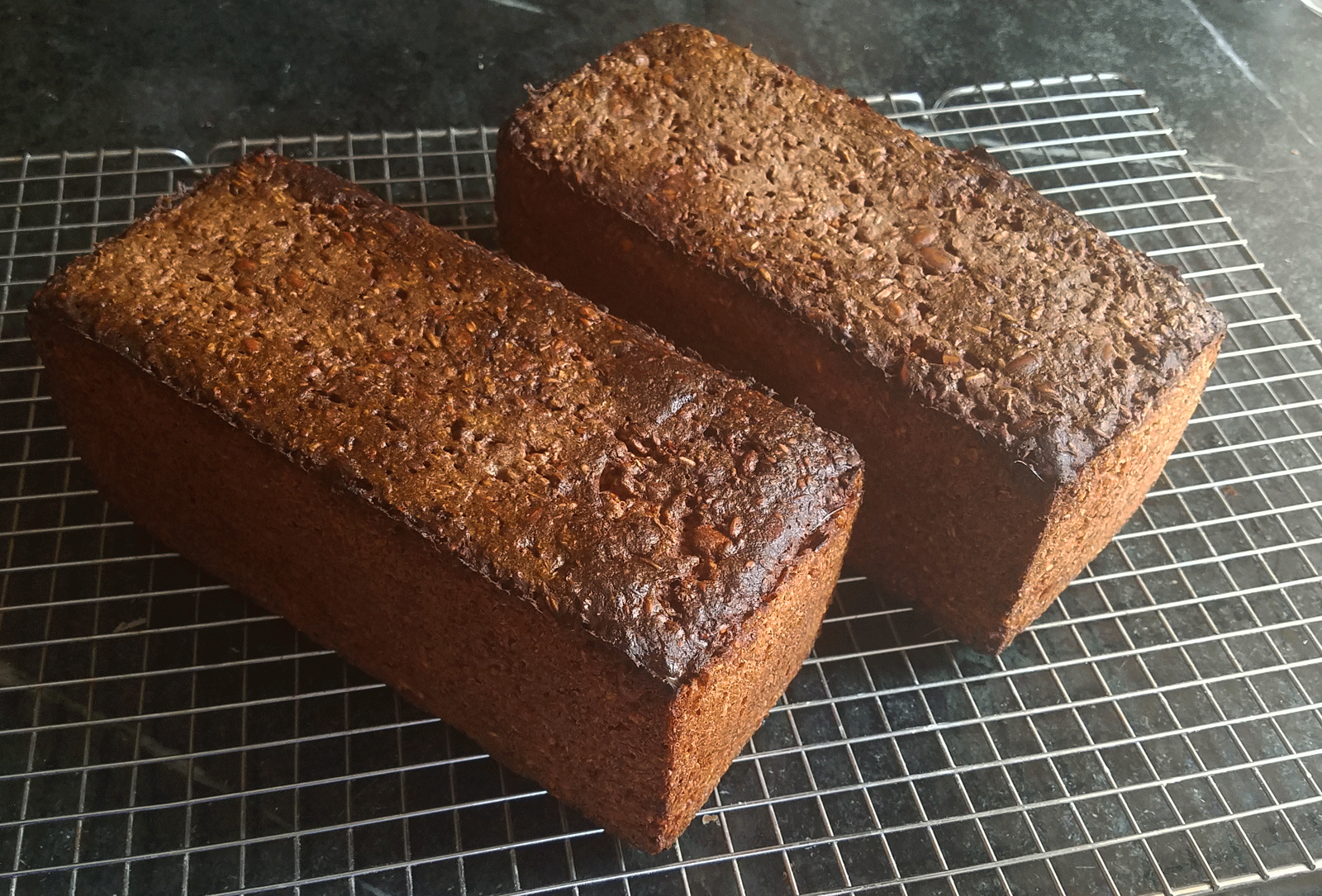
Jean Etue
October 20, 2017My favorite type of bread.
Hana
October 22, 2017Is that really whole wheat flour to go into this bread? Should I use only rye instad of wheat?
Stanley Ginsberg
October 22, 2017I suggest you follow the recipe the first time and then try different variations. I think this bread will also work as 100% rye, but expect it to be denser and gummier.
Jon
October 22, 2017You call for 10 g sour rye culture but you don’t explain how to get the sour rye culture, elaborate.
Stanley Ginsberg
October 22, 2017rye sour culture = sourdough starter fed with rye flour. i generally hydrate at 100% and inoculate with 10% starter culture.
Susan
October 22, 2017I made this using 100% rye and it was magnificent. I just goofed up and missed the fact that the third mix used whole wheat. Not gummy. I followed the recipe to the letter in all other respects. Husband enjoyed a slice with good butter and pronounced it excellent. He is thinking that heating a slice in the toaster oven instead of toasting it, will unlock the flavor for breakfast with some Manchego or Petit Basque cheeses. I had only one Pullman style pan of the correct length and had to make do with a lighter and slightly shorter pan for the other portion of the dough. Of course this translated into different baking results, with the shorter and thinner pan loaf baking out about 10 minutes faster than the Pullman loaf.
Stanley, would there be any advantage in parking your loaf pans in the oven atop a baking sheet?
Stanley Ginsberg
October 22, 2017None that I can think of ….
Bread Winner
October 22, 2017Found this recipe a little late as I had already started Tartines method for Rene’s Rye but used some of your methods and tweaked the ratios in both to make this interesting loaf! Next time I’ll start with the preferment sponges. Thanks for the post and recipes! Getting your book soon 🙂
mebake
October 23, 2017Thanks a ton for sharing, Stan!
Marisa
October 23, 2017Somewhat overdone at 70 minutes. As a result, it is overly rusty but still delicious. I’ll definitely make it again, perhaps reducing the temperature part way through and am wondering about covering the pullman pans during the bake. Your advice is welcomed.
p.s. Mr. Ginsberg, you’re making it hard for me to bake my way through your book, as so many of the blog recipes catch my eye!
Marisa
October 23, 2017whoops – I think I typed my email on the above comment; corrected below.
Stanley Ginsberg
October 24, 2017Ovens vary and the baking times reflect my own experience and my own oven. I’ve always found that it’s best to monitor internal temperature as baking times approach the bottom of their range and let the thermometer tell me when my bread is done.
Elizabeth Miller
October 25, 2017Thanks for posting the recipe – I’ve made it and it came out great. I’m enjoying a slice right now (with lots of butter). However, it is a bit sweeter than I prefer, so I’m wondering what happens if I reduce or eliminate the molasses altogether? Would I have to adjust anything to compensate for the loss of moisture?
Stanley Ginsberg
October 25, 2017I don’t think omitting the molasses will affect the formula in any significant way. If you find the bread too sweet, feel free to leave it out.
Marta
October 31, 2017Thank you so much for sharing this fantastic recipe. Excellent whole grain bread, so different from feather like brown colored bread like products on the market. Wakes up my deeply hidden nostalgia for the country left behind, as many of Polish breads look and taste very similar.
Maria
November 30, 2017Where did you get this recipe from? I’m interested in making “authentic” Danish rye bread as a surprise for a Danish friend living in the states, but having never been to Denmark I am at a loss as to which recipe I’ve come across online is the most “real”. Do you think this could fool a Dane?
Stanley Ginsberg
December 4, 2017It came from a Danish cooking blog. If you Google Rugbrød på surdej, you’ll find dozens of recipes.
Patti
December 22, 2017Baking these now. For some reason I came out with 3.25-3.3 pound loaves…but it works out because my Pullman loaf pans are 10.25″ x 5″. Not sure how this happened since I weighed everything as it went in ?? Though I did use 10 gms more of dark molasses and 10 gms more of starter accidentally. Can’t wait to taste!
Stanley Ginsberg
December 22, 2017hi. Prebake weight of the dough is 3.00 kg total or 6.81 lb. I generally assume 15% shrinkage during baking, but if shrinkage is less, then your loaves are well within expected final weight.
Mihoko
January 4, 2018Hi Stan,
Do I really need beer for this bread? I don’t buy beer, and I was wondering if there was any substitute for beer. Thank you
Stanley Ginsberg
January 5, 2018use water instead, or even buttermilk. both will work equally well, although with slightly different flavor notes from the beer version.
Mihoko
January 5, 2018Stan, thank you for your advice! I often buy buttermilk. I can use it for substitute.
Jessica Bongibault
January 11, 2018Thank you very much for this recipe Stanley. Which kind of beer did you use? A dark one?
Stanley Ginsberg
January 11, 2018I believe I used a hefeweizen — a pale Bavarian wheat beer.
dkinvoker
January 14, 2018Is the Coarse rye meal just whole grain rye flour that is not finely ground? Can I exchange it with rye bran?
Stanley Ginsberg
January 14, 2018Yes and no. Coarse rye meal is the whole grain, including bran (outer layer), endosperm (starchy inner core) and germ. Bran is only the “skin” of the grain and consists almost entirely of fiber: it won’t form a dough, let alone a loaf.
Joe_n
April 19, 2018I made it!!
I used buttermilk in place of the beer, and walnuts for the pumpkin and sunflower seeds.
This the first time eating a nearly all whole rye bread. It is delicious sliced thin. It is a 3 day bake but so worth it. The last rise in the loaf pan took the full 5 hrs. I baked it to 205 F.
Thank you for this recipe. It is much easier than a sourdough.
Mimi
June 12, 2018Hi. If I cannot access coarse rye meal is it possible to substitute it with anything? Thanks!
Mimi
June 12, 2018Hi. Would rye chops work in place of the coarse rye meal?
Abe
August 18, 2018Just mixed the first sponge. One question though…
Wouldn’t 6% salt on the second sponge affect the yeasts/bacteria in the culture even though in the final dough it’s down to a normal 2.3%?
Gwen K
August 26, 2018Just made this – outstanding! I was out of pumpkin seeds so used walnuts. I used OMB Copper, a local brew that is an Altbier, which really complemented the flavors without overpowering. I used a hefeweizen in another recipe of yours that called for beer, and thought it was too mild for the flavor to come through. Only took 55 minutes to bake – I use sprouted flours, which always seems to bake faster. Thanks for another fantastic recipe!!
James Shanley
October 21, 2018Hi Stanley,
I made this bread, and using your weights came up with three Pullman loaves, not two. Are you using the longer Pullman tins? The loaves I baked were a little on the dense side. Should I just divide the dough in two and increase the time a bit? I only have shorter Pullman pans.
P.S. I attended your Rye Crackers class at the Kneading Conference. Excellent! Loved your jokes, too.
Stanley Ginsberg
October 21, 2018hi James, glad you appreciate my humor (some don’t). As for the breads, do what works for you: if you’re more comfortable with three loaves instead of two, go right ahead. In either case, it’s important to make sure the loaves proof properly, so that the top surfaces show broken bubbles, and that you bake to an internal temperature of 203F. Happy baking!
James Shanley
October 21, 2018Will do!
Anders Svensson
October 28, 2018Hi! I just found this inspiring site. I really like ryebread (Rågbröd in swedish) and I just read about your so interesting trip to Finland and the baltic. It’s great you travel so far to enjoy our nordic bread. I will certainly continually read this site and try, for example , this recipe 🙂
Best regards!
Anders Svensson
Norrköping, Sweden
Stanley Ginsberg
October 28, 2018Thank you!
Kelly
December 15, 2018I live in Australia and can’t seem to find caoarse rye meal anywhere. Is there anything I can substitute that for?
Stanley Ginsberg
December 22, 2018If you can’t find whole rye berries and grind them coarsely, then I suggest you use cracked wheat. The flavor won’t be as intense, but you’ll get the texture and mouth feel.
Joseph Czika
January 15, 2019When I had this bread or one similar to it in Denmark, I remember the crumb being more moist than mine. In fact the moisture seemed due to oil or butter added to the mix. This recipe has either and my creation turned out to be very dry. The density seemed right, but what can I do to increase the moisture content?
Stanley Ginsberg
February 16, 2019I’d start by adding more water. In general, recipes aren’t carved in stone but represent starting points, since flour absorbency can vary depending on variety and climate.
Pingback: Sourdough Danish Rye/Rugbrød på surdej – allfoodsmagazine.com
Anders Svensson
July 10, 2019Hi! I love danish rye bread and this recepty is great, BUT 225°ç in 75 minutes makes the top surface burn. What about 180°C!
Karen
November 25, 2019Hi, 2 loaves is quite a lot for us, but I don’t like to meddle with recipes, does this bread freeze OK?
Stanley Ginsberg
December 6, 2019It freezes beautifully.
Andrew
December 5, 2019Course rye meal seems hard to get hold of in the UK. Any suggestions?
Stanley Ginsberg
December 6, 2019If you can find whole rye berries, crush them coarsely using a grain mill or (very carefully) a food processor. Otherwise, substitute wholemeal rye flour and increse water by 3-4%. You won’t have as rustic and chewy a mouth feel, but the flavor will be spot on.
Alistair
June 24, 2020Hi Stanley,
I‘m also in Australia and struggling to find coarse rye meal. Could you just run through how to make it from whole rye berries in a food processor (and perhaps explain what you mean by very carefully)? I have just got my hands on a copy of your book and the first loaf was wonderful, I’m so excited about working my way through some more of them!
Stanley Ginsberg
July 14, 2020It shouldn’t take more than 3-4 pulses to break the rye berries into coarse meal.
PS. I’m so glad you like the book! Thank you.
Karen
December 14, 2019Chopped organic rye is the stuff you need, Shipton Mill sells it Andrew.
Andrew
December 6, 2019If I don’t want to make 2 loaves, can I just halve the quantities? Can I substitute rye flakes for the coarse rye meal?
Stanley Ginsberg
December 6, 2019Halving the formula is no problem, although I suggest baking two loaves and freezing one of them, since the bread freezes beautifully. As for the coarse rye meal, see my reply below.
Andrew
December 14, 2019Thanks
Andrew
December 14, 2019I have made a starter and given it 4 feeds and should be ready to begin making my loaf. Right now there is a thin film of liquid on top and a slightly alcoholic and pleasant smell, but not much evidence of bubbles. I’ve just stirred the liquid in and when it settled I could see just a few very small bubbles. Am I OK, or has my starter failed?
Stanley Ginsberg
December 14, 2019How long since its last feeding?
Andrew
December 14, 20192 days now (it’s 1.30am here, so 3 day by tomorrow. Actually, prompted by your email, I have just got it out of the airing cupboard to look and it’s starting to bubble away nicely, so I think that all is OK. Thanks a million for getting back to me.
Marta
May 2, 2020Thank you for this recipe, loved it!
Steve E
June 2, 2020Hi Stanley,
A related question about ‘Danish Rye Bread’ from your wonderful book. My loaf (which is still in the oven) is going off the rails and I am wondering why. It started with ‘There will be little or no visible expansion of the dough’. On the contrary, after 45 minutes at 75 F, mine had risen and overflowed the 9x9x4 Pullman pan, dripping huge globs onto the countertop. I trimmed the loaf and put it into the oven for 10 minutes of baking with steam. More overflow. I trimmed that off too and now (15 minutes later, with the steam pan removed) the entire loaf has collapsed back down.
I am a very careful, fairly experienced, home baker and followed all your steps exactly. I’m milling my own rye berries so my approximations of ‘medium rye flour’ and ‘coarse rye meal’ might be slightly off but this has always worked fine in the past (I made your Valais Rye a few days ago and it was fantastic). Any thoughts on what might have gone so wrong this time?
Thanks,
Steve
Stanley Ginsberg
June 23, 2020I’m mystified. It may be that I originally baked it in a 13″ Pullman and then changed the pan size but not the quantities, or it may be that your leavening is far more robust than mine. If I had to choose, I’d have to go for the former … for which I offer abject apologies. Next time, try reducing the quantities by 25% or so.
Jim
July 18, 2020Hi Stanley, in May, I had the exact same fail as Steve E with the Rugbrod recipe in your book.
I followed the recipe precisely, and the only mistake on my end was getting interrupted by a work phone call and letting the dough proof for 20 minutes too long. The dough was just over the edge of the pan and spilling onto the counter in the 45 minutes of proofing in the recipe, even though the recipe said there would be little or no visible expansion, even with a large amount of yeast. The dough was overflowing messily when I put it in the oven, but I think it would have exploded in the oven even if I had put it in right away. I saved myself a terrible oven cleanup by placing a sheet pan on the rack below the pan, but all of the dough overflowed out of the Pullman, leaving a hollow mess inside it.
I’m glad you mentioned that the original Pullman pan length was 13″, that explains a lot. I’m thinking that the quantity in the book should go in two 9×4 “Pullmen”, not one–4 lbs of dough and 20 mg of yeast is a lot, compared to your Valais rye (excellent!) and other recipes, and the Zingerman Dinkelbrot I’ve been making in two “Pullmen”.
Lorraine G.
June 23, 2020I live in the high desert of Nevada… at 4,200ft. in elevation. In baking artisan and rye breads I’ve never been able to achieve a final internal baking temperature of over 201 F. More commonly the final internal bread temp is 199-200 F. I can’t believe that some recipes call for breads to reach 208 F temp. The only reason that I think of is that the recipe writers live near sea level. However, there one blogger who makes wonderful breads who instructs in his recipes to bake to 208 F internal temp – and he lives in Albuquerque! [Usually my breads seem to be fine – to me – at the temps I can achieve.]
Gizell
July 2, 2020Echoing the comments of Steve. I have been baking from your wonderful book as well. I happened to look at my proofing bread at the 20 minute mark……lift off over the edge of the 9X5X3 pan! I was happy that I had already preheated the oven with steam and put it in immediately. Further expansion. Also, I have found that your specified oven temps and cooking times for all of the breads I have tried thus far- Dakota Norwegian, New York Corn, Old Milwaukee and the Danish Rye are too hot [ my Miele oven is confirmed accurate ] and too long [ my Danish Rye was at 208 F a full 30 min before specified time elapsed [ I have started testing temps much earlier and I will be reducing oven temps ] All that being said I have enjoyed reading and baking from your book and intend to continue my trials. As for the Danish Rye…….I now have extraordinary croutons from the over risen, overbaked top ! Thank you.
Stanley Ginsberg
July 14, 2020Ovens vary. The temperatures in the book worked in my Bosch ovens and seem to have worked for others as well. Did you perhaps set your ovens as convection? If so, that would explain it.
Steve E
September 16, 2020I am again trying ‘Danish Rye Bread’ (not this recipe but the one from the book) this time with much less yeast than called for: 14 grams instead of 20. The result is more or less the same as last time: the proofed loaf rose about a centimeter above the edge of my 9″ Pullman pan. That’s better than last time, when it overflowed onto the counter, so I went ahead and baked it according to the recipe. Within minutes it overflowed big globs into the steam pan. I continued baking and the center later collapsed 1-2 centimeters. It smells wonderful and will probably taste good. But I will now abandon this yeasted recipe and switch to the sourdough version on this post.
Bob
September 8, 2020This is the first time I’ve made this bread and I had two issues. First, I had the opposite experience from Steve. The recipe in the book says that there will be little or no visible expansion of the dough. The version here in the blog says that the dough should double during each of the proofs. I had no doubling and no broken bubbles on the surface. Perhaps my dough needed more liquid at each step but I was also wondering if that means my rye sour culture is no longer active.
Second, like Gizell, I got an over-baked top and sides that I had to cut off so next time I will lower the oven temp slightly and not use the convection setting.
That said, the bread was delicious and I will definitely make it again!
Laura
January 18, 2021Do you have a brand or two of “light molasses” you would recommend? Is it something other than molasses which is not blackstrap? Confused. I cannot locate any products called “light molasses.”
Stanley Ginsberg
February 7, 2021My go-to product is Steen’s Cane Syrup from Louisiana, which is available online. You can also use dark corn syrup.
Bengt
May 11, 2021Sorry for this late reply. But for this type of bread I use coarse rye flour and substitute any wheat flour with finely ground rye flour. And yes ovens and pan shape can vary the results. I let mine go to 97°C.